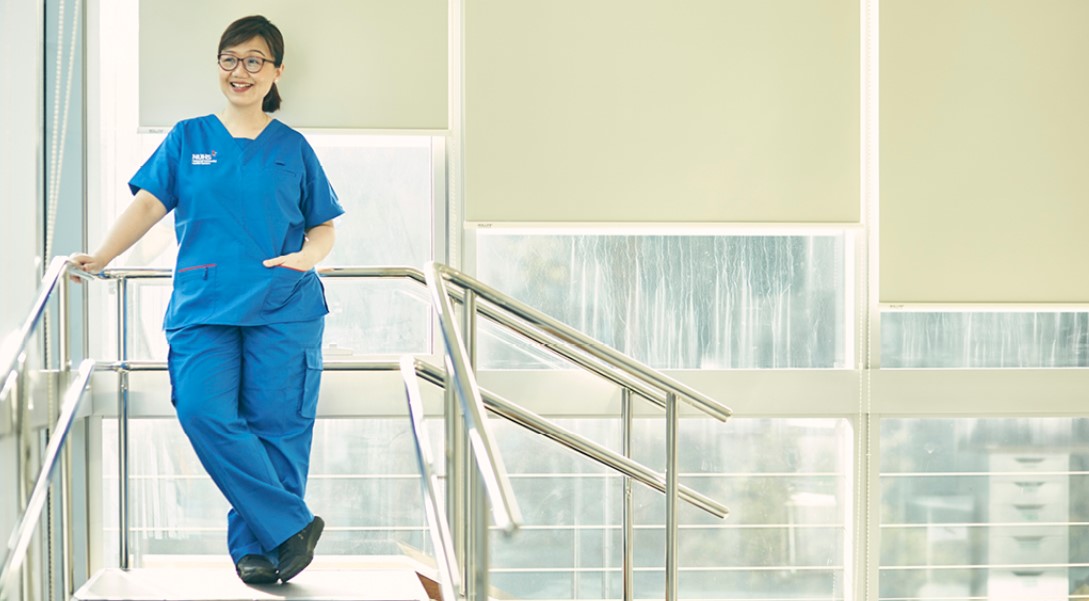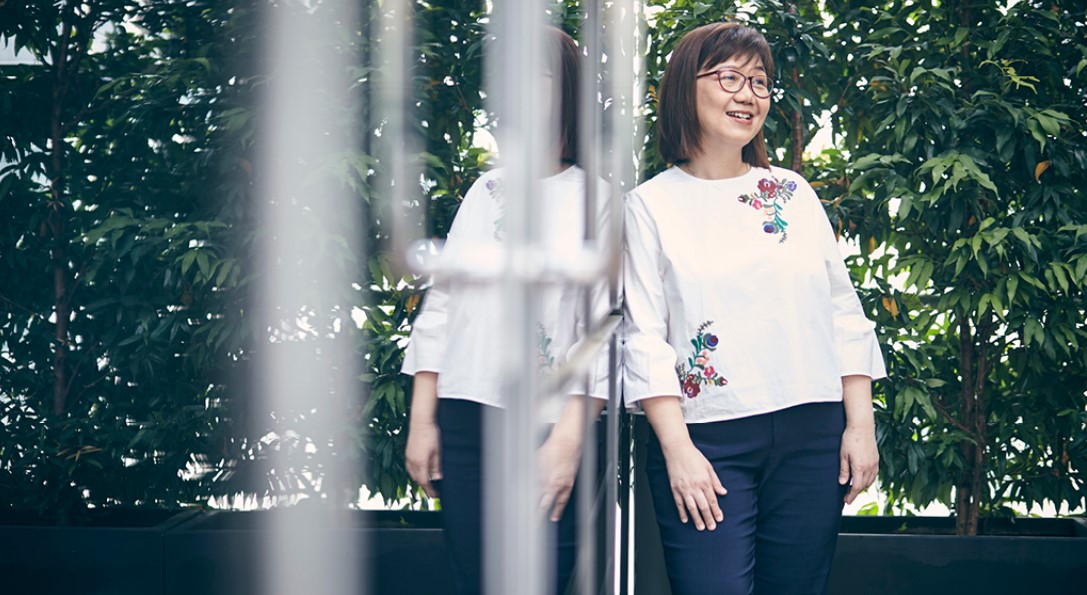Katherine Leong: Giving reassurance to Covid-19 patients at Tuas South CCF


Despite working numerous shifts under the hot sun swathed in layers of PPE, Katherine Leong remains upbeat for her team and her patients
Imagine being diagnosed with a new and unknown virus when you’re all alone in a foreign country, miles away from your family and loved ones. All you know is that the infection can be fatal. That was the scary situation that many migrant workers here found themselves in.
For those who were sent to the community care facility (CCF) at Tuas South, they were relieved to have found a soothing, reassuring voice who told them that they were in good hands and well on the road to recovery.
“It’s good that you are here. It means that your symptoms are mild, or that you’re recovering. Take this time to rest,” the voice said. That voice belongs to Sister Katherine, assistant director of nursing, nursing administration, and advanced practice nurse, Khoo Teck Puat – National University Children’s Medical Institute, National University Hospital.
In April, at the height of Covid-19 infections in Singapore, the chief nurse at NUH (National University Hospital) asked Katherine Leong if she was willing to step up and do Covid-19 response work.
The 49-year-old assistant director of Nursing, Nursing Administration, had no idea what she was signing up for at that time. She had just one question: “How can I help?”
That’s Katherine, or Sister Kat (as she’s known among nursing staff due to her seniority) in a nutshell – always the first in line to contribute to a cause for the greater good.
[[nid:511494]]
Katherine, along with a six-member core group from National University Health System, went on to set up a 1,622-bed CCF at Tuas South CCF, modelled after the one at Singapore Expo.
It was to house migrant workers who tested positive for Covid-19, but had mild symptoms, or were asymptomatic. Taking a leaf from Expo CCF, the team referred to the migrant workers as “brothers”.
Katherine had hoped that this term would foster a sense of familiarity between them and the healthcare team. She would even station herself at the entrance to greet the migrant workers who were checking in.
“We just wanted to make the experience less stressful for our brothers,” she explains, emphasising that she wanted them to know that they would be properly taken care of.
The experienced nurse even went a step further and tried to engage them in their native language, says Dr Paul Zhao Songbo, senior consultant, Department of Ophthalmology at NUH.
“Some were obviously quite nervous and lost, and she tried to alleviate that with a warm smile and a reassuring greeting. As a nurse, she truly has a heart for her patients, regardless of their background,” he adds.
Katherine and her team only had two weeks to turn a factory into a care facility for Covid-19 patients – which was no small feat.
What they had in front of them was a flatted factory with three disconnected buildings, equipped with cargo lifts which were deemed unsafe for use as regular passenger lifts. This was a far cry from the infrastructure at Expo CCF. The nursing team under Katherine was to be in charge of Tuas South CCF’s clinical services – to ascertain all procedures, from admission and treatment protocols to emergency treatments.
[[nid:479879]]
“Apart from devising processes on assessing the residents’ vital signs and monitoring clinical stability, we had to work out logistical solutions as well. What if someone were to collapse in one of the units on the third floor of one of the blocks? How would we bring them down for treatment? Or do we go up and resuscitate them?”
On top of that, they had to handle recruiting procedures for locum staff. The team comprised of people from different faculties and varied specialities who had little or no prior interactions with each other. Or as Katherine puts it, “strangers who had come together for a common purpose”.
There was barely time to even exchange pleasantries – they had to hit the ground running even before the first day. To have such a specialised group of people collaborate so seamlessly is indeed remarkable. Dr Lim Yinghao, associate consultant, Department of Cardiology at National University Heart Centre, Singapore, credits Katherine for running a tight ship and always being on the ground.
“Katherine is an excellent team leader. She was able to guide her staff through the many changes, especially in the early start-up phase of the facility, while maintaining high morale. Under her charge, the nursing presence at Tuas South CCF was always well-run and in high spirits,” he says, adding that it was her leadership skills that made it possible to “organise and motivate a hastily-assembled group of hospital-based and locum nurses to contribute effectively”.

It was equally important for Katherine to keep up the morale among the medical staff – from maintaining a well-stocked pantry, to ensuring that they were paid transportation benefits.
As such, the team affectionately called her “mother hen”, because she was always looking out for the team. On top of that, one would always find her in the thick of the action and by the side of her nurses, rather than playing just a supervisory role.
“Many times, I have walked through the facility to see her busy with patient orientation, or helping out at the medical post. That is perhaps her defining trait, that she is happy to be working beside her nurses without pomp or fanfare,” adds Dr Lim.
As a testament to her spirited nature, the locum staff at Tuas South CCF have indicated that regardless of the heat, humidity and distance, they enjoyed going to work every day. Many have subsequently applied for jobs at NUH.
The camaraderie the team shared at Tuas South CCF is something that Katherine treasures and is determined to keep alive, even after the facility has shut. Assistant nurse clinician Yeoh Lin Dai, from the National University Cancer Institute, Singapore, can vouch for that.
“Sister Katherine continues to go the extra mile to keep in touch with us, through being informed about our work, and also lovely surprise visits.”

Such empathy is innate, according to her older brother Benedict Leong. He describes “Kat” – as she is fondly called by family – as “caring, open-minded, and completely trustworthy”, the epitome of a perfect sister.
Her younger sister Joanne Leong agrees, and lets on that during that period of time, Katherine was also shouldering the responsibility of caring for their late father, who suffered from Parkinson’s disease and dementia. He passed away in September.
Being the only nurse among her siblings, Katherine had insisted on taking over from her brother as their father’s condition worsened. But as Katherine’s commitment to her job increased, the siblings rallied together to take care of their father intermittently.
“Despite her busy schedule and, at times, the long hours and weekends that she needed to put in at work, her priority and focus were always on my father. No matter how tired she was when she returned home, she would still spend time with our dad, talking to him, cheering him up, and making sure he was well taken care of,” adds the younger Leong.
It was equally important for Katherine to be an indulgent mother to her two boys aged 12 and 14, and a caring employer to her domestic helper.
While the siblings were very proud of their sister, they were worried about her being exposed to the virus. This was a concern that Katherine had to alleviate among her team as well. Her worried colleagues would often ask her if it was safe for them to go back home, for fear of passing the virus on. Her response had always been: “What’s stopping you from passing the infection on is your PPE.”
For that reason, Katherine had always insisted that her team master the donning and doffing (removal) processes before being given the green signal to enter the “red zone”, as the infection area was termed.
[[nid:439804]]
It was also made mandatory that staff should not stay in the “red zone” beyond three hours at a stretch. This is due to the layout of the facility, as Katherine and her teams were all set up in carnival tents outside and fully exposed to punishing Singapore temperatures.
“Before long, we would be dripping with sweat and in need of hydration,” she recalls. The team also had to follow additional safety measures before leaving the premises for the day.
“I am proud, and rather humbled, to say that there were no infectious transmission amongst all the staff posted at Tuas South CCF.” She credits its successes to the support and camaderie from all levels of staff, from upper management – including the CEO, COO, and Chief Nurse, to the ground staff comprising of doctors, nurses, and operations people.
After almost three months at Tuas South CCF, Katherine is back at NUH. She’s also finding more of such project management roles landing on her table, no doubt due to her performance at Tuas South CCF. But for now, she’s also prioritising some self-love.
“Exercise is high on my list. Weight was not a problem when I was at the CCF as we were running around so much, but now I have some weight to take off,” she smiles. Coming from a determined woman, we know that it’s just a matter of time before that goal is reached.
This article was first published in Her World Online.